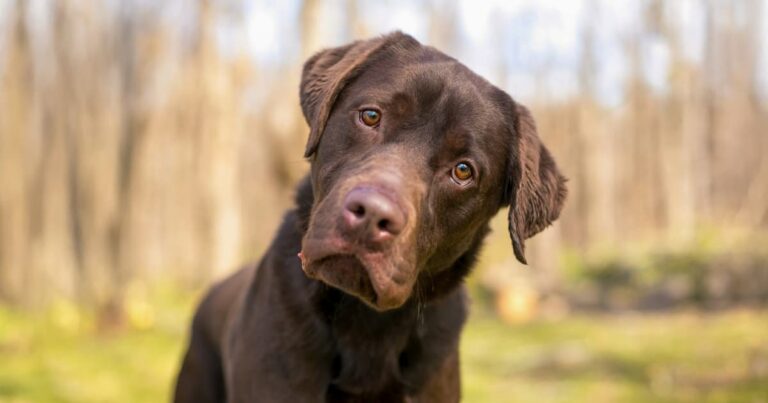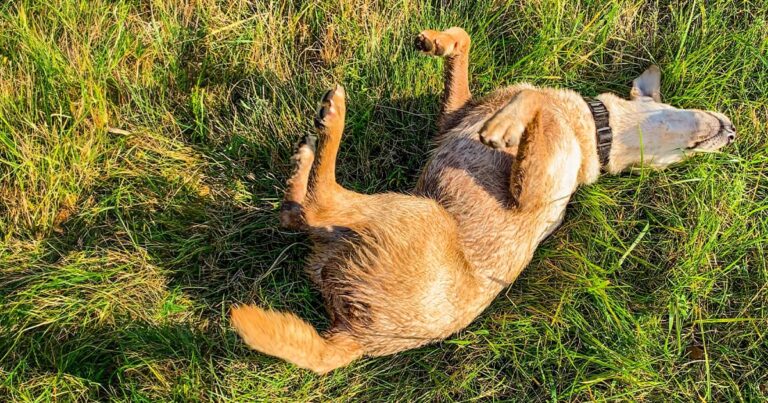The festivities of the holiday season may be a little scary, stressful and downright weird for your dog — for example, why are there strange-looking dogs with sticks on their heads in the front yard? Dog anxiety is very real, so to help your dog cope with what can be a stressful season, we’ve suggested some tips to help ensure that, in your dog’s world, all is calm (and bright).
Signs of Dog Anxiety
Dog anxiety can manifest in different outward displays of behavior. Here are some common signs you might see with dog anxiety: scratching at the door, whining, barking, pacing, having accidents, repetitive or compulsive behaviors (like obsessive licking) or destructive behavior (like chewing furniture). Below we have some suggestions for managing anxiety in dogs during the holidays.
How to Keep a Dog Calm: Puppy Stress Relief
One of the most important things to do is create a safe place for anxious dogs to escape to if the holiday festivities and events are getting a little too festive for them. Place their crate (or bed) in a quiet room with some of their favorite toys and a few treats for comfort. This will make a nice cozy place to retreat to, if your dog’s anxiety becomes too much.
You should also put their food and water bowls nearby so they don’t need to go back into the party to eat or drink. Whether your dog is potty trained or still learning, it’s a good idea to take them out every few hours and not wait for them to tell you they need to go. An anxious dog may be too scared to let you know their usual way.
Dogs with Anxiety Need Space
It’s inevitable that when friends and family visit (or you visit them), they’re going to want to play with your adorable dog. Because who doesn’t like puppy snuggles? However, your dog may not feel the same way. Some dogs experience anxiety meeting new people or in a new environment, particularly if they haven’t been through a lot of socialization training. It’s a good idea to ask your visitors to restrain from immediate puppy hugs and give your dog plenty of time to get acquainted with everyone first.
Your dog may also meet some new canine friends during the holidays. Before visiting friends or family members who have dogs, check that their dogs are tolerant of other dogs, particularly if you have a puppy — senior dogs can get grumpy very quickly with a young whippersnapper nipping at their ears. Take the introduction slow and watch for signs of anxious or aggressive behavior, and make sure neither dog is uncomfortable with the situation.
Traveling During the Holidays with Dogs
Traveling for the holidays can add a whole other layer of stress for your dog, particularly as it disrupts their routine. If you’re planning to take a trip with your dog, first check with your veterinarian that it’s OK for your dog to travel.
Flying in particular can create an anxious dog with all of the loud noises and strange smells. So if you need to fly, it might be better to look at pet care options for your dog while you’re away, like a pet sitter or friends. Staying at home may also be a good idea for anxious dogs. On the other hand, leaving your dog with new humans could cause separation anxiety issues. Getting your dog used to their pet sitter before you leave can be a good option to help prevent separation anxiety.
If you’re traveling by car, it’s a good idea to crate train your dog so that they’re safely contained and you aren’t distracted by a dog bouncing on the seats or trying to jump out the window. A rule of thumb used by some veterinarians and professional dog trainers is for a puppy to spend no longer than one hour in the crate for each month of age, up to nine to ten hours. However, others advise no more than four to five hours at a time (with the exception of nighttime). For more travel tips, check out this post on traveling safely with your pet.
Food, Glorious Food (But It’s Not for Puppies!)
One thing your dog will be very excited about during the holidays is the smell of ALL. THAT. FOOD. Their nose will be working overtime trying to find the source of those mouth-watering scents. While it’s tempting to give your dog a treat from your plate, feeding table scraps or other human-food treats is not a good idea, as it could lead to tummy trouble — and dealing with doggy diarrhea is not the best welcome for house guests. So keep the treats dog-appropriate to avoid added holiday stress (for both of you).
Don’t forget to keep grapes and raisins, alcohol, chocolate and sugar-free candy and baked goods (that could contain xylitol) away from a curious dog’s mouth, as all of these can be toxic to dogs.
Avoiding Dog Holiday Hazards
In a previous post we talked about the 12 pet hazards of Christmas, and it’s worth highlighting some of these again, as they can definitely add some holiday stress and anxiety for dogs and dog owners. First of all, dogs, especially puppies, chew — it’s what they do and they do it well. Protect them from an unwanted shock by covering exposed electrical cords in protective casing, taping them down or securing them under a rug. If your dog is an avid chewer, you may need to skip the lights altogether. The flashing lights may cause some dogs anxiety, so that’s another reason to keep the lights packed away. If you do use lights, make sure you turn off and unplug lights when you’re not home.
The other main hazards for dogs are all the pretty things that they shouldn’t eat. Products like ornaments, tinsel and small toys can be dangerous for dogs to chew or swallow. Broken ornaments and sharp toys can cause cuts in their mouth, and if they swallow small toy parts or tinsel, it could cause intestinal injury or blockage.
Keep in mind that holiday plants are another ingestible hazard. Mistletoe, Christmas or English holly and, to a lesser extent, poinsettias can cause gastrointestinal upset. So keep these out of reach from your dog.
The holiday season with your dog can be fun and memorable. Just remember that anxiety in dogs can occur in even the most laid-back of dogs, so give them a peaceful spot to enjoy the festivities from afar. If your dog’s anxiety becomes unmanageable, ask your vet for advice. They can treat anxiety in dogs with prescription medications or can refer you to a veterinary behaviorist.







